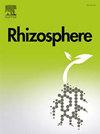Investigating the influence of antagonistic fungi Polydomus karssenii and Niesslia gamsii on the penetration of Heterodera filipjevi and Pratylenchus thornei in wheat
IF 3.4
3区 生物学
Q1 PLANT SCIENCES
引用次数: 0
Abstract
Plant parasitic nematodes (PPNs) significantly impact global wheat production. Strategies for managing PPN include developing tolerance/resistance varieties, crop rotation, and the use of nematicides. However, nematicides are highly toxic and have a non-target effect on the soil biota, emphasizing the need for safer alternatives and innovative approaches. This study investigated the suppressive effect of two nematode egg parasitic fungi, Polydomus karssenii (Ashrafi et al., 2023) and Niesslia gamsii (Ashrafi and Maier, 2017), on the penetration of the cereal cyst nematode (CCN) Heterodera filipjevi (Madzhidov, 1981) and the root lesion nematode (RLN) Pratylenchus thornei (Sher and Allen, 1953) into wheat roots. Two nematode-susceptible wheat cultivars, Bezostaya and Seri, were treated with P. karssenii and N. gamsii. Germinated seeds were dipped in a fungal suspension before being inoculated with the nematode species. Nematode penetration was evaluated at 48 h, 72 h, and 1 week after inoculation using acid fuchsin staining and microscopical examination. The results revealed that both fungal treatments reduced nematode penetration in both cultivars compared to untreated controls, with P. karssenii showing higher overall effectiveness. Polydomus karssenii reduced penetration of H. filipjevi by 91.9% and P. thornei by 85.9%, while N. gamsii reduced penetration of H. filipjevi by 76% and P. thornei by 67.3%. Additionally, fungal treatments delayed nematode penetration, no penetration was observed at 48 h in treated plants, while nematode penetration was observed in untreated plants during the same period. This study underscores the potential of P. karssenii and N. gamsii as sustainable biological agents against nematodes and emphasizes their role in integrated pest management strategies for wheat production.

求助全文
约1分钟内获得全文
求助全文
来源期刊

Rhizosphere
Agricultural and Biological Sciences-Agronomy and Crop Science
CiteScore
5.70
自引率
8.10%
发文量
155
审稿时长
29 days
期刊介绍:
Rhizosphere aims to advance the frontier of our understanding of plant-soil interactions. Rhizosphere is a multidisciplinary journal that publishes research on the interactions between plant roots, soil organisms, nutrients, and water. Except carbon fixation by photosynthesis, plants obtain all other elements primarily from soil through roots.
We are beginning to understand how communications at the rhizosphere, with soil organisms and other plant species, affect root exudates and nutrient uptake. This rapidly evolving subject utilizes molecular biology and genomic tools, food web or community structure manipulations, high performance liquid chromatography, isotopic analysis, diverse spectroscopic analytics, tomography and other microscopy, complex statistical and modeling tools.
 求助内容:
求助内容: 应助结果提醒方式:
应助结果提醒方式:


